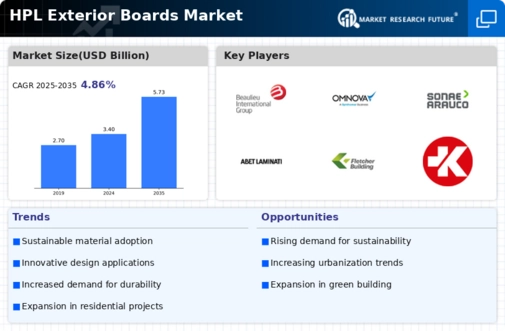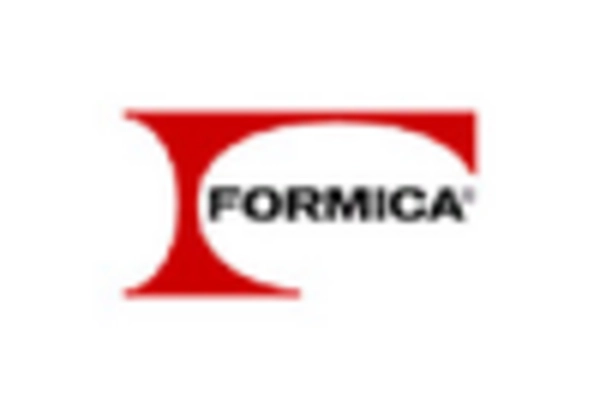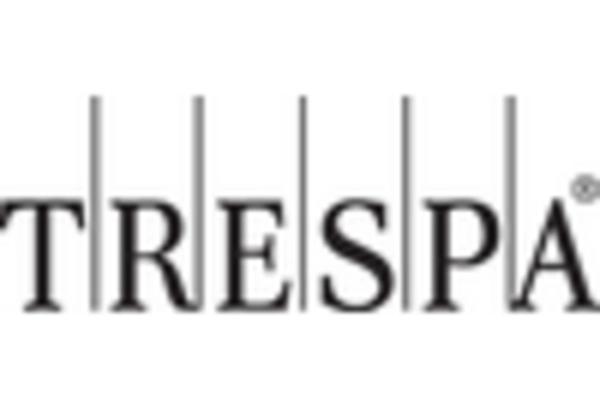Technological Innovations
Technological advancements are reshaping the HPL Exterior Boards Market, driving efficiency and product quality. Innovations in manufacturing processes have led to the development of HPL boards that are not only more durable but also easier to install. Enhanced production techniques, such as digital printing and advanced surface treatments, allow for greater design flexibility and improved performance characteristics. Market analysis suggests that these technological improvements are likely to attract a broader customer base, including those in sectors such as hospitality and retail, where visual impact is crucial. As manufacturers continue to invest in research and development, the HPL Exterior Boards Market is poised for growth, with products that meet evolving consumer expectations for quality and innovation.
Sustainability Initiatives
The increasing emphasis on sustainability is a pivotal driver for the HPL Exterior Boards Market. As environmental concerns gain traction, consumers and businesses alike are gravitating towards eco-friendly materials. HPL boards, known for their durability and recyclability, align well with these sustainability initiatives. In recent years, the market has witnessed a surge in demand for products that minimize environmental impact. This trend is further supported by regulatory frameworks that encourage the use of sustainable materials in construction and architecture. Consequently, manufacturers are innovating to produce HPL boards that not only meet aesthetic requirements but also adhere to stringent environmental standards. The HPL Exterior Boards Market is thus positioned to benefit from this growing consumer preference for sustainable building materials.
Customization and Aesthetic Appeal
Customization is increasingly becoming a key driver in the HPL Exterior Boards Market. As architects and designers seek unique solutions for their projects, the demand for customizable HPL boards is on the rise. These boards can be tailored in terms of color, texture, and finish, allowing for greater creativity in building designs. This trend is particularly evident in commercial and residential projects where aesthetic appeal is paramount. Market data indicates that the customization segment is expected to grow significantly, as consumers are willing to invest in personalized solutions that reflect their individual tastes. The ability to offer bespoke options positions manufacturers favorably within the HPL Exterior Boards Market, catering to a diverse clientele seeking distinctive architectural elements.
Regulatory Compliance and Standards
Regulatory compliance is emerging as a crucial driver for the HPL Exterior Boards Market. Governments and regulatory bodies are implementing stringent building codes and standards that mandate the use of high-quality materials in construction. HPL boards, recognized for their fire resistance and durability, are increasingly being specified in these regulations. This trend not only ensures safety but also promotes the use of advanced materials that enhance building performance. As compliance becomes a focal point for architects and builders, the demand for HPL boards is expected to rise. The HPL Exterior Boards Market stands to benefit from this regulatory landscape, as manufacturers align their products with evolving standards to meet market needs.
Urbanization and Infrastructure Development
Urbanization is a significant driver influencing the HPL Exterior Boards Market. As populations migrate towards urban centers, the demand for new infrastructure and housing is escalating. This trend necessitates the use of durable and aesthetically pleasing materials, such as HPL boards, in construction projects. The rise in urban development projects, including commercial buildings, residential complexes, and public spaces, creates a robust market for HPL exterior solutions. Data indicates that urban areas are increasingly adopting HPL boards due to their weather resistance and low maintenance requirements. Consequently, the HPL Exterior Boards Market is likely to experience sustained growth as urbanization continues to shape the architectural landscape.

















Leave a Comment